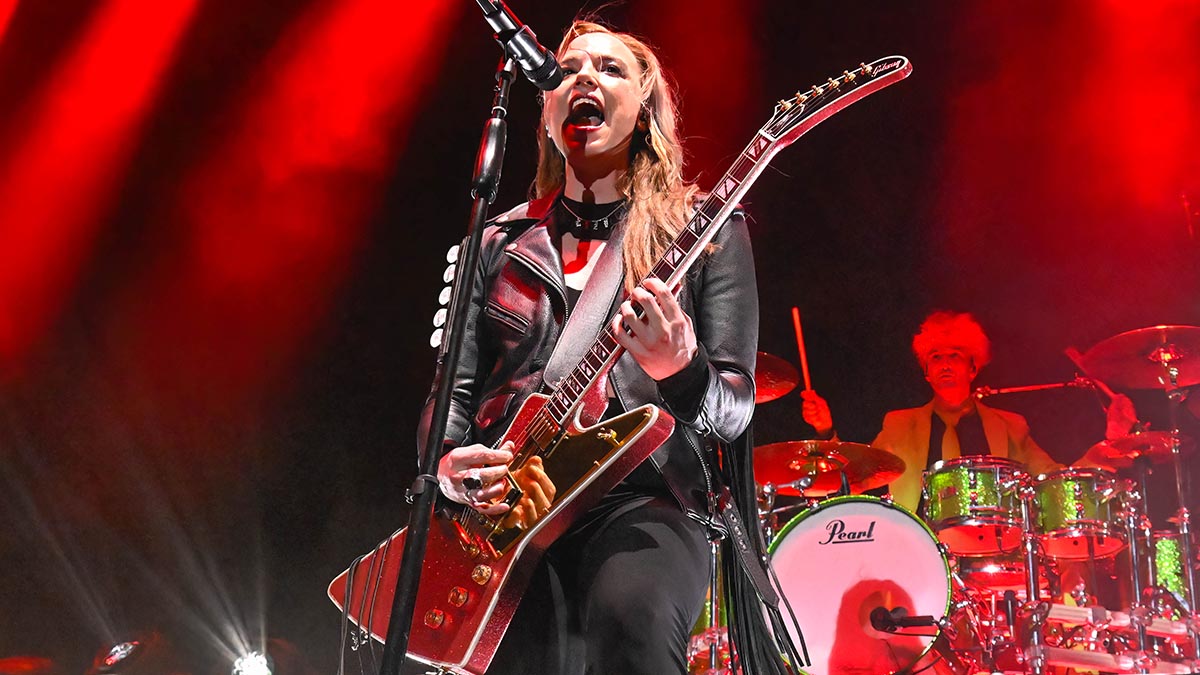“My best advice to all guitarists is to sit down and write the things you practice”: Halestorm’s Lzzy Hale talks tone tips, meat and potatoes rock, and reveals how a fan gave her an original Klon Centaur
The Gibson Ambassador and Kramer signature artist checks in to share six-string wisdom, the secret of keeping it simple, and why she made a guitar that looks like it came from the '80s

In the promotional video for her new Kramer Voyager signature guitar, Lzzy Hale can be seen passing her guitar through a television set into the hands of a young girl dreaming about her future life as a musician.
And while this advert, which premiered on Gibson TV back in December, certainly does its job in selling the latest model for the Halestorm singer/guitarist, there’s also a deeper message and meaning behind it. And rightly so, given that Hale has now joined an elite handful of players (Slash, Jerry Cantrell, and Dave Mustaine) as a Gibson Brand Ambassador – in her case, marking the first female player to be awarded such a lofty and highly coveted title…
“I love that it’s being talked about so much,” Hale says. “Something like this gives all the girls out there even more permission to pick up the instrument. I know there are some women who might feel, ‘Why are you even mentioning it, can’t you just let the talent speak for itself rather than play up to being the first female whatever?’ But for me, it’s a personal choice…
“Because I remember what it would have meant for me when I was growing up. I was looking for someone I could see my reflection in, and there wasn’t really anyone... these conversations weren’t even happening. When I was younger, female musicians were just a novelty. People would think, ‘Oh, you’re talented’ and then say, ‘Oh, we’re going to put you on the girl’s night at the local club!’
“I had to work very hard to get here. I want all the girls out there to know if I can do this – some dork from Pennsylvania with no music contacts or clue how to play when the band started – then so can they. Nothing is impossible!”
What exercises and practice regimes helped you become the player you are today?
“Not many, because I get distracted easily! But I do try to practice with a metronome, especially before we start touring, going through simple pentatonic shapes. One thing I love to do is make something up on the spot with my voice. Then I will mimic it on guitar, switch on the metronome and slowly increase the speed.
Get The Pick Newsletter
All the latest guitar news, interviews, lessons, reviews, deals and more, direct to your inbox!
“There’s a simplicity in creating something from nothing. It doesn’t have to go with anything. It can just be a cool idea that inspires me to work on my technique. I will make sure each note rings clearly and ask myself if I should use downstrokes or alternate picking. Or does it sound better played in triplets?
“My best advice to all the guitarists out there is to sit down and write the things you practice. That’s what stops me from getting bored. On the other hand, Joe [Hottinger, Halestorm lead guitarist] is very regimented. He’ll work on different techniques for weeks until he figures it out. I don’t have that attention span! It has to be instantaneous. I never think about being good at something in two years' time… it’s more like, ‘I’m gonna do this tonight!’”
Some of your most famous riffs are in drop D. What is it about that tuning that inspires you?
“Drop D is childish reckless abandon for me. I was actually a piano player first. I switched over to guitar when I was 16 because we lost our first guitarist. I didn’t know what to do! But the only people left were me and my little brother on drums, so I was forced into learning and then fell in love with it. I didn’t know if we’d ever find another guitarist. Maybe it was going to be two of us like The White Stripes!
“I had a few lessons and then one of my friends introduced me to drop D, which saved my life because we had shows coming up and I needed to learn things fairly quickly with the least amount of effort. All I needed to remember was what fret to play rather than different shapes!”

And then of course there’s the extra heaviness it creates…
“I love the gritty sound of it. Our bass player Josh [Smith] would be fascinated by some of my ideas, asking me why I came up with specific things, like playing a regular powerchord shape but in drop D, which would create a different sound. It helps you skip a couple of steps and take the brain out of it, using more of a primal instinct.
“That can be detrimental, because you’re not learning in a chronological way that gives you a good foundation for later, which I realized later in life. I was a bit lazy in the beginning. I didn’t bother learning chords or scales, so later on I had to buckle down.
“But those early moments gave me songs like It’s Not You, all spurred from that naivety. It was just me being dumb, but also not being scared by that. I was diving head-first into the shark tank!”
So what would you say is the hardest Halestorm riff to play?
“Which is the one I get wrong the most? I think there’s definitely a dance with I Am The Fire because I use a double-neck. Some of it is in drop A, other parts are in standard. It’s a heavy guitar… I should have gotten it chambered but my pride got in the way! I guess the most complicated riff I’ve written is It’s Not You. And even though I’m mimicking the guitar with my vocals, Uncomfortable is another hard one.
“You might think singing and playing the exact same thing is easy but it’s really not. The one I’m most proud of is Daughters Of Darkness, which came from those teenage years of drop D experimenting. I often find the simple parts are the hardest to get right. We love hypnotic simplicity: meat and potatoes rock ’n’ roll that will hit the back of the arena and make the most impact, rather than overcomplicate things and become too self-serving.”
We love hypnotic simplicity: meat and potatoes rock ’n’ roll that will hit the back of the arena and make the most impact
You’ve tended to stick with Gibson Explorers going into Marshall JCM800s. Is that still your main recipe for tone?
“Tone is an ongoing quest for me but a lot of it comes down to simplicity. I’m still running those Marshalls. Recently I’ve backed off the distortion from the amp and become more dependent on an Ibanez TS9 Tube Screamer, the little green guy, or some kind of boost. I’ve also been experimenting with using two amps, which goes back to when I was starting out.
“Back then I had a Mesa/Boogie Dual Rectifier and one of my dad’s old Fender Bassman amps, which sounded very clean. Those two amps combined worked so well – one being overly saturated and the other being completely not that. That sound is something I’ve always been after because it’s clean, and very human-sounding, but also with a heaviness you can hide behind! There has to be a deeper tonality, you can’t just sound like white noise.”
Are there any other pedals that you simply couldn’t live without?
“One of my favourite pedals was gifted to me by a fan outside our bus, an original Klon. I’ve been generous and let Joe borrow it… or rather, steal it! That is one pedal I always have close by. It sounds classic and there’s something very unique about it – you dial in a great tone and then it works more like an icing on the cake, creating a nice sheen.
“The Jerry Cantrell signature is my favourite wah and I’ve been using that for years, but recently I’ve been using my fingers to create that kind of effect, making certain parts pop out and sound more vocal.”
This new Kramer is built for one purpose and that’s to be a screamer!
As for the new signature guitar, the combination of the Black Diamond Holographic Sparkle finish, single pickup in the bride and Floyd Rose makes it quite the eye-catcher…
“This guitar has been a long time coming. I love one-trick ponies, the instruments that are just like, ‘Hey, I just do this but I do it well!’ That’s why I love the Joan Jett Melody Maker. You just have one pickup and a killswitch, that’s it! You don’t even need to turn the volume down.
“This new Kramer is built for one purpose and that’s to be a screamer! I was trying to imagine what kind of guitar I would have been playing in the mid-’80s. In 1986 they were using some kind of holographic lead car paint for guitars but I could not find that… probably because it’s not legal anymore!”
It’s a very different beast to last year’s Gibson Explorerbird – which made history for combining the body of an Explorer with the headstock of a Firebird…
“That idea came about because I was at NAMM doing stuff for Gibson. We went out for dinner and Cesar Gueikian [CEO] was there. He’s like the rock star over at Gibson, coming up with all the epic shit. I realised that night you have to be very careful what you say around him because even if it’s just a silly idea, he will say, ‘Oh yeah, we can figure that out for you!’
“And at the time I was saying how cool an Explorer/Firebird hybrid would be. I was just spitballing, I wasn’t saying, ‘Let’s do it!’ Months later, this white guitar showed up at my house with a note saying: ‘We made this for you, maybe it could be what we work on next?’ So yeah, be careful around that guy, otherwise a guitar might show up at your doorstep!”
- Back From the Dead is out now via Atlantic.
Amit has been writing for titles like Total Guitar, MusicRadar and Guitar World for over a decade and counts Richie Kotzen, Guthrie Govan and Jeff Beck among his primary influences as a guitar player. He's worked for magazines like Kerrang!, Metal Hammer, Classic Rock, Prog, Record Collector, Planet Rock, Rhythm and Bass Player, as well as newspapers like Metro and The Independent, interviewing everyone from Ozzy Osbourne and Lemmy to Slash and Jimmy Page, and once even traded solos with a member of Slayer on a track released internationally. As a session guitarist, he's played alongside members of Judas Priest and Uriah Heep in London ensemble Metalworks, as well as handled lead guitars for legends like Glen Matlock (Sex Pistols, The Faces) and Stu Hamm (Steve Vai, Joe Satriani, G3).
"Upgrading from your entry-level acoustic opens the door to an entirely new world of tonewoods, body shapes, and brands": 6 signs it's time to upgrade from your first acoustic guitar
"I'm past my prime": 5 common excuses for not learning the guitar – and 5 body and mind-boosting reasons you should





![[from left] George Harrison with his Gretsch Country Gentleman, Norman Harris of Norman's Rare Guitars holds a gold-top Les Paul, John Fogerty with his legendary 1969 Rickenbacker](https://cdn.mos.cms.futurecdn.net/TuH3nuhn9etqjdn5sy4ntW.jpg)





